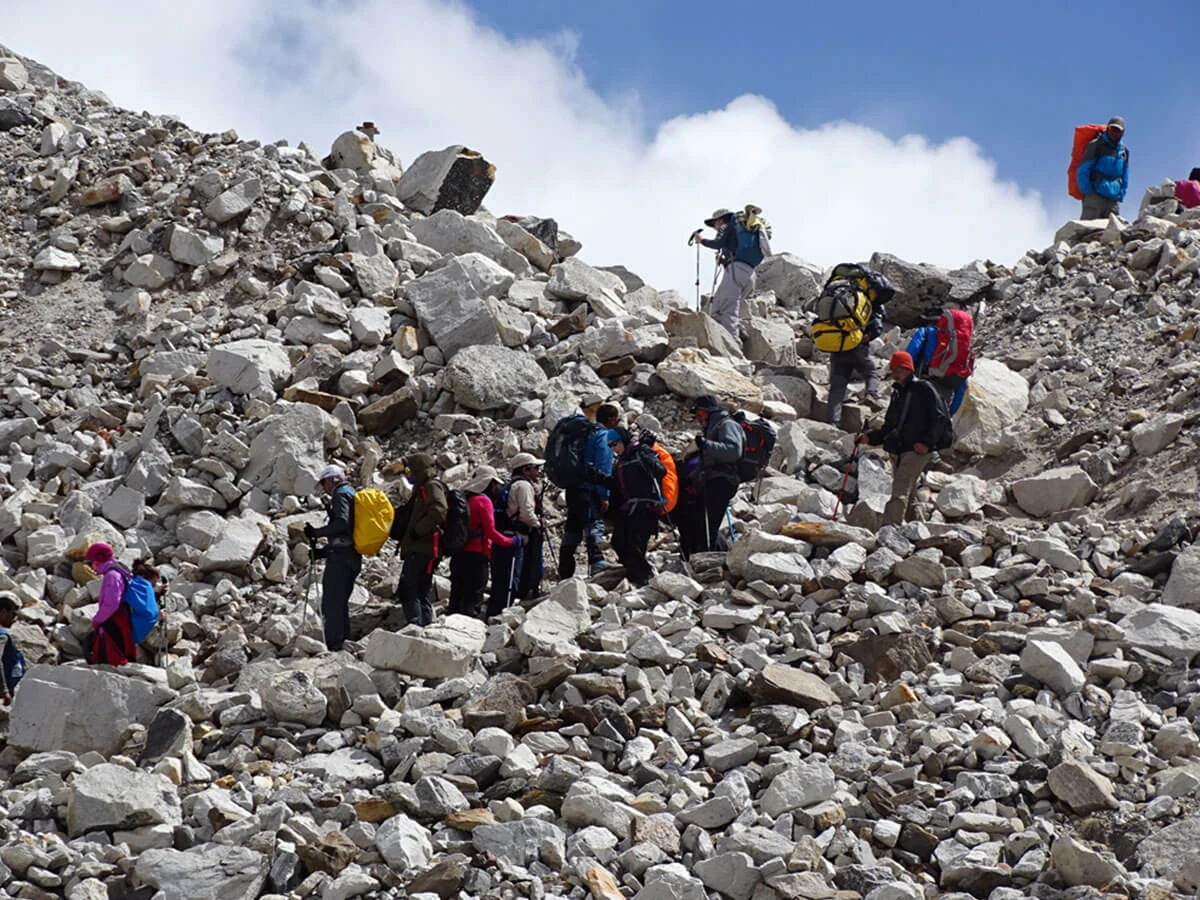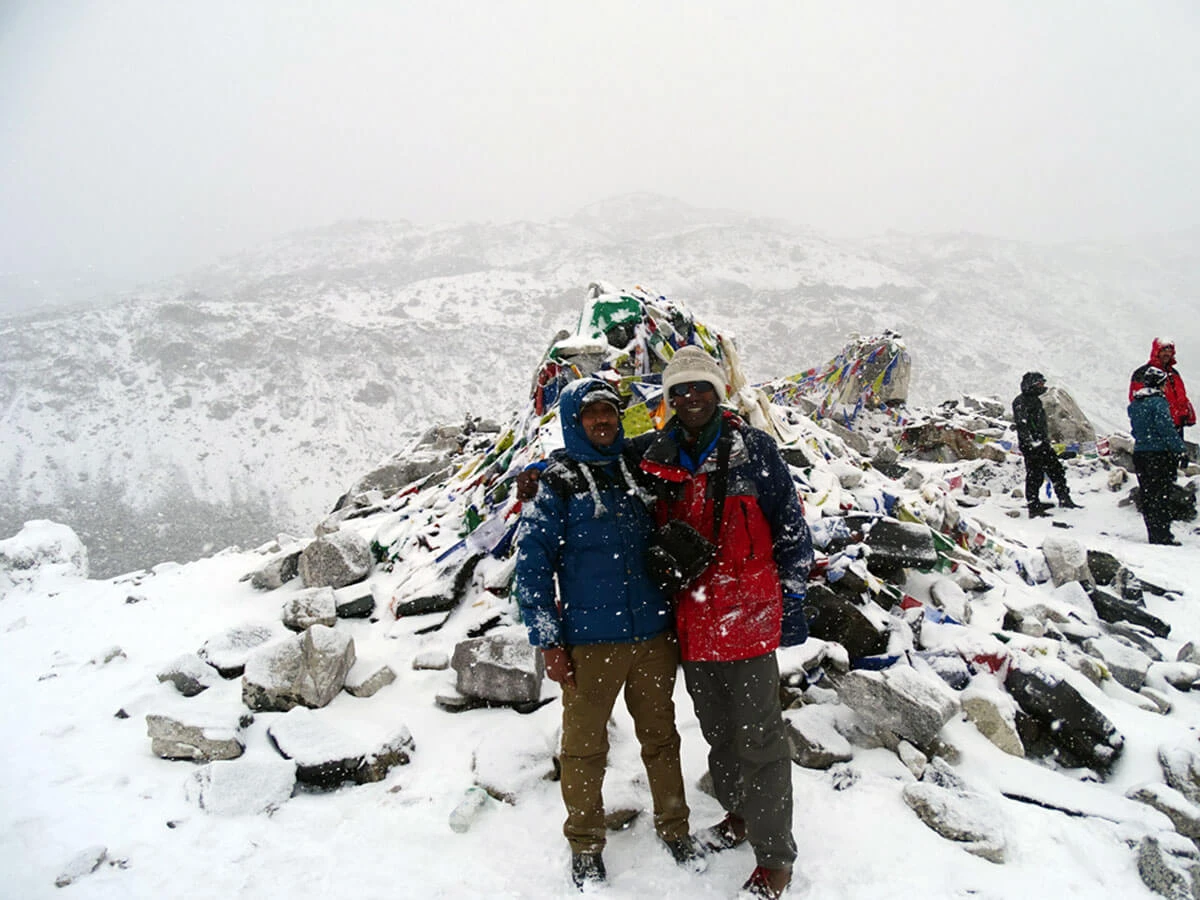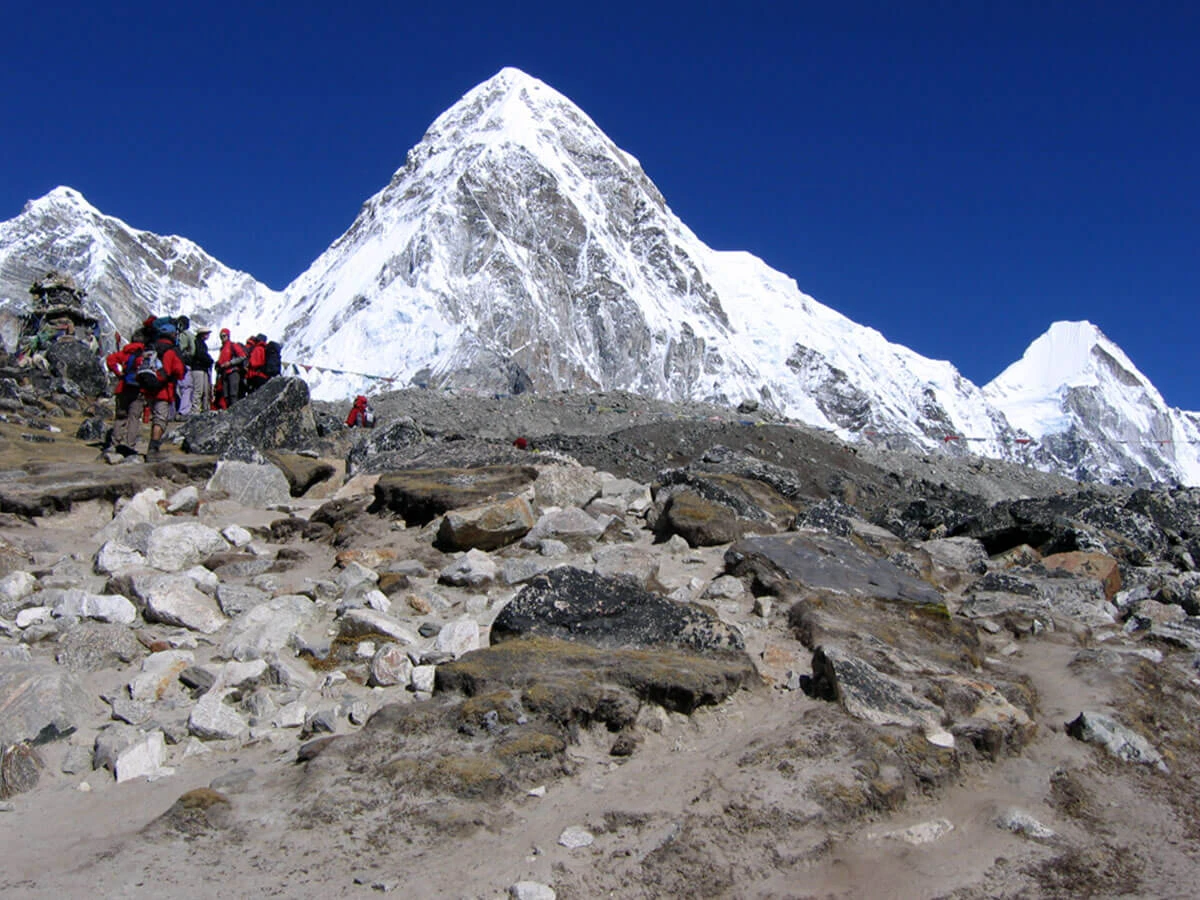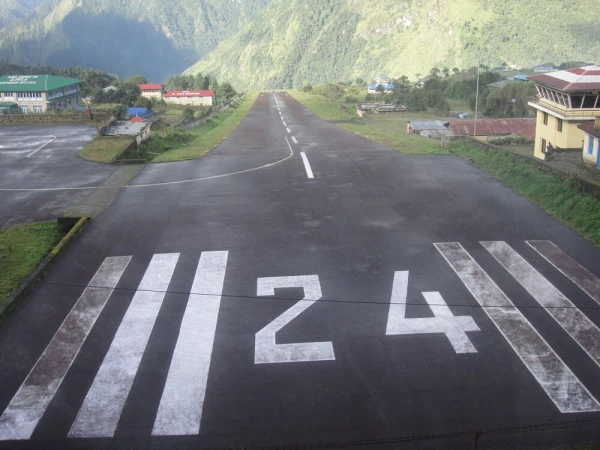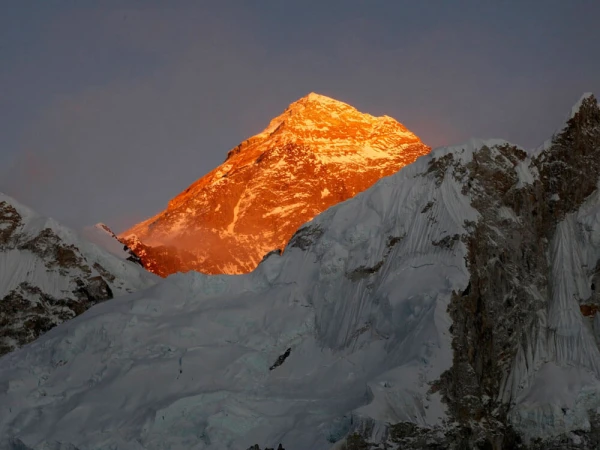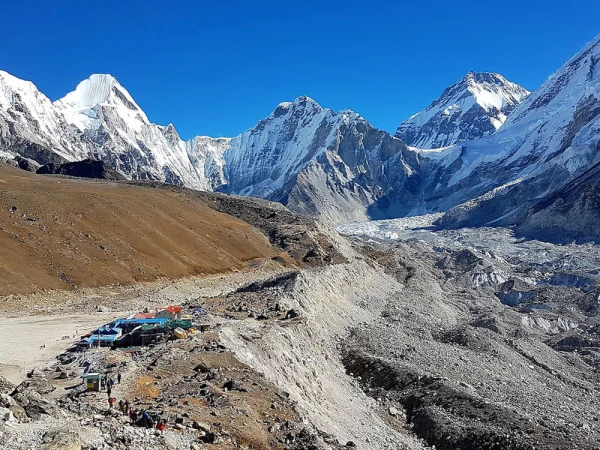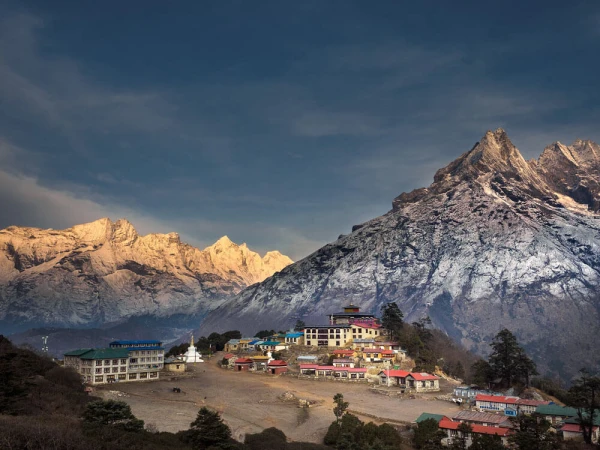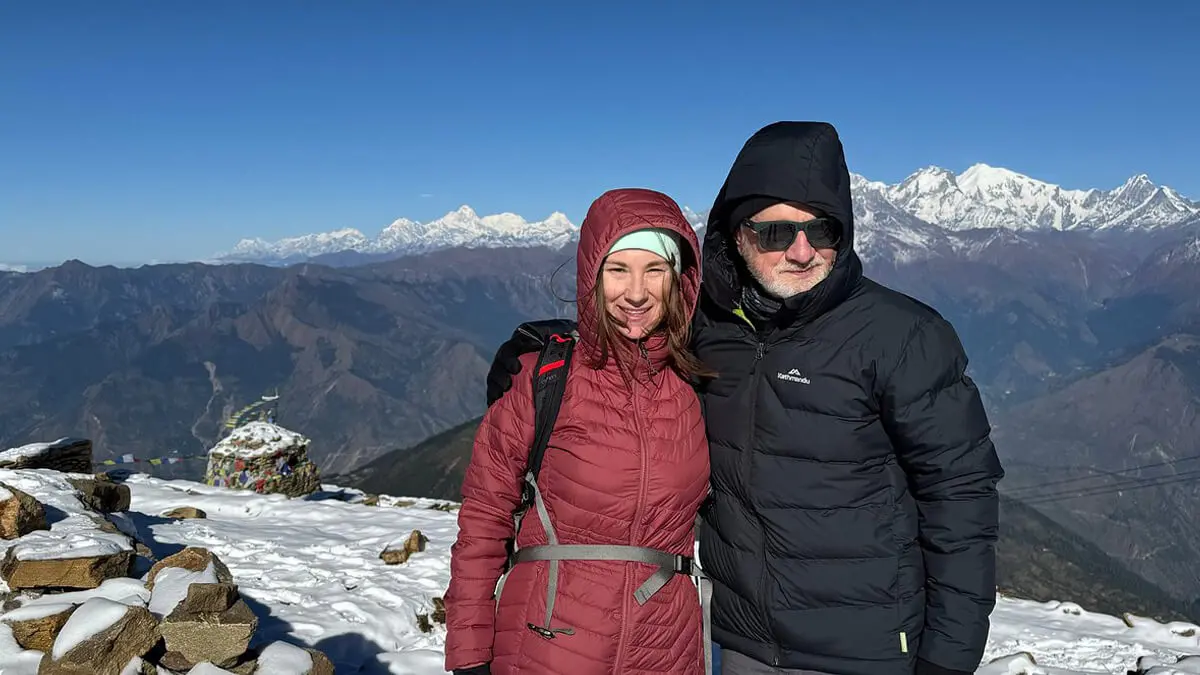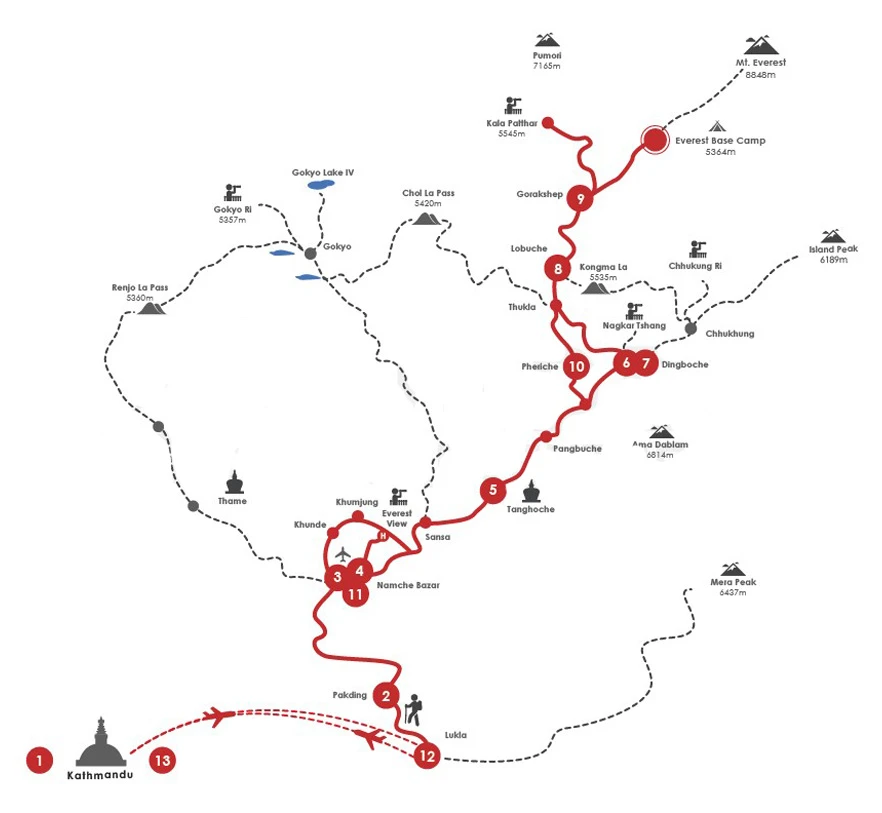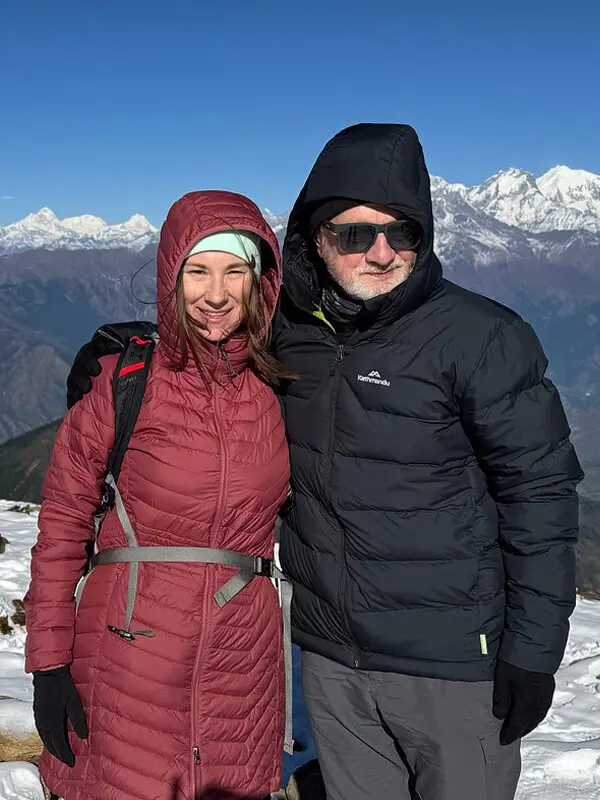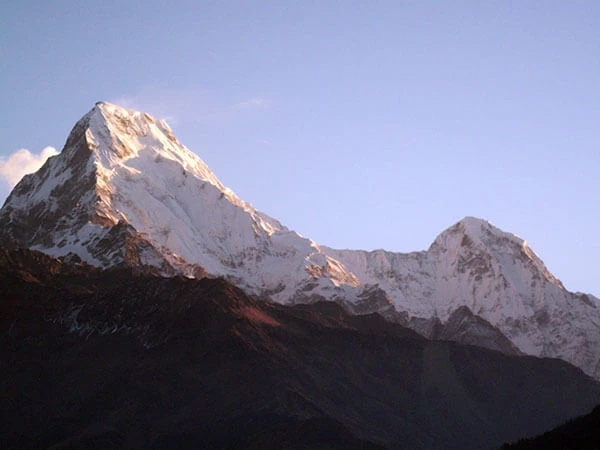The Everest Base Camp trek is one of the most adventurous, fulfilling, panoramic, and life-changing trekking programs in the Himalayas of Nepal. You will fly across the world to Kathmandu, a bustling Nepali city known for its ancient temples and palaces.
From Kathmandu, you will take a very uncomfortable but thrilling and scenic short flight to Lukla Airport. The Lukla flight is nothing less than an adventure in itself. Flying in a tiny-tinny propeller aircraft is something you do not experience every day.
The trek starts from Lukla. If you want to buy trekking clothes and essentials in Kathmandu (which we highly recommend), arrive here one day before the trek starts.
There are tons of shops selling all kinds of trekking clothes, gear, and other essentials in Thamel, the tourist hub in Kathmandu. You will find budget-friendly to mid-range and ample high-end trekking gear.
And trekkers who do not wish to invest a lot of money into high-quality gear but would love to use them can rent. Coming back to Lukla, you will meet your porter here. Trekking with a guide and porter is very normal.
We will arrange a friendly, expert guide and porter for you if you book the Everest Base Camp trek with us. The guide will most likely meet you in Kathmandu and join you for the journey.
From Lukla, you will trek all the way up to the Everest Base Camp and Kala Patthar. Mind it, there is no road for vehicles along the Everest Base Camp trek route, so travelers have to walk.
In total, the Everest Base Camp trek distance is 130 kilometers. You will walk 65 km while ascending and follow almost the same route and distance while returning back to Lukla.
Trekkers who are on a short vacation or just want to skip the return 65 km walk can opt for a helicopter flight from Gorak Shep to Lukla or Kathmandu. Gorak Shep is the last settlement before EBC and also the way to Kala Patthar.
So, helicopter flights for trekkers are usually operated from here. In between Lukla and Everest Base Camp, you will spend seven nights in different Sherpa villages.
Our Everest Base Camp trek itinerary includes two acclimatization days that extensively lower the risk of altitude sickness. Sherpas are one of the major inhabitants of the Everest region (aka Khumbu region in Nepali words).
You must know them for their strength and resilience, but they are also very friendly, fun, and kind human beings. Every trekker who does the Everest Base Camp trek always raves about how nice Sherpas and other local communities are.
For us, reaching the Everest Base Camp is not everything about this trek. The journey, the interactions with the locals, the simple mountain lifestyle and delicious meals, beautiful sunrises & sunsets, the company of fellow trekkers from around the world, the strong trekking community, the mesmerizing landscapes and never-ending mountain vistas, the bustling evenings in lodges and peaceful moments in between the trekking hustle, and the rich cultural heritage makes more sense. These are the things that make the Everest Base Camp trek "Great"!
Highlights
- Embark on the top trekking adventure and hike to the base of Mt. Everest, the tallest mountain on Earth
- One of the most adventurous, fulfilling, panoramic, and life-changing trekking programs in the Himalayas
- Explore Kathmandu, a bustling Nepali city known for its ancient temples and palaces
- Experience the famous Lukla flights in a tiny-tinny propeller aircraft
- Trek through rhododendron forests and cross several suspension bridges
- Spend nights in beautiful Sherpa villages and meet many other mountain communities
- Go on exciting side hikes during acclimatization in Namche Bazaar and Dingboche village
- Visit ancient monasteries like Tengboche and Pangboche along the trail
- Reach the Everest Base Camp and see the close view of the Khumbu Icefall
- Witness a stunning sunrise and a surreal panorama of Mt. Everest from Kala Patthar
- Enjoy a simple mountain lifestyle, delicious meals, and bustling evenings in lodges
- Witness diverse landscapes and breathtaking mountain vistas throughout the journey
What to expect during the Everest Base Camp trek?
The Everest Base Camp trek is a full package. Adventure, cultural experiences, tranquility, challenges, wilderness, you name it, and this trek has that.
There is never a dull moment during the Everest Base Camp trekking!
- Varying weather and climate conditions: You will traverse different climatic zones during the Everest Base Camp trek 14 days. So, you will experience varying weather and climate conditions. With the increase in altitude, the exposure to sun and wind increases, and the climate gets colder.
- Lots of uphill and downhill walking: You cannot guess the amount of uphill and downhill walking the Everest Base Camp trek includes. For the entire 130 km, you will either ascend or descend. And the sections that have flat trails are also not normal flats. It's a "Nepali Flat". That's why your fitness plays a big role in making the EBC trek challenging or moderate for you. Check out our Everest Base Camp trek map below for an illustrated view of the trail.
- Acclimatization days: Our Everest Base Camp trek itinerary has two rest days. One is in Namche Bazaar, and the other is in Dingboche village. These are rest days during which trekkers hike to high elevations and return to sleep at the same village to acclimatize. From Namche Bazaar, you will hike to Hotel Everest View, and from Dingboche, you will hike to Nangkartshang Peak.
- Rugged terrain and diverse vegetation: The Everest Base Camp trail follows rugged mountainous terrain. You will trek through lush rhododendron and pine forests and gradually ascend to bushes and alpine pastures before making it to the glacier zone. Given this variation in elevation, you will discover diverse vegetation while trekking.
- So many suspension bridges: You will be surprised to see the number of suspension bridges you cross, especially between Lukla and Namche Bazaar. Among all suspension bridges, the longest one is the Tenzing Hillary Suspension Bridge. It is 135 meters high and 600 meters long.
- High altitude and potential risks of altitude sickness: The Everest Base Camp trek is a high-altitude trek that will take you above 5,500 meters above sea level. If you are not used to high elevations, trekking will become challenging. It doesn't only make the trek physically demanding but also contains the risk of altitude sickness. So, we take acclimatization breaks and ascend slowly.
- Busy trails and bustling evenings in lodges: Spring and autumn are peak seasons for the Everest Base Camp trek. Thousands of trekkers do this trek in these two seasons. Therefore, the trails and the lodges are busy. The environment is quite delightful. If you love meeting new people, you are in heaven.
- Extra charge for basic services: Life in the Everest region is not that easy. Everything costs money. Bringing food and other essentials up in the mountains is expensive, and there is no infrastructure for a stable electricity or mobile network. So, locals have extensively invested in alternatives like solar power, and therefore, little things like charging and hot showers cost extra money.
- Unreliable network: Consider your Everest Base Camp trek a break from the digital world. Inform your family about your itinerary and share our contact with them. During the trek, do not think about the internet at all. Just enjoy nature and the journey.
- Ancient monasteries, stupas, chortens, and prayer flags throughout the trail: As much as the Everest region is remote, the cultural heritage of the locals is equally rooted. Mountains, lakes, and valleys are sacred to the locals. The Everest Base Camp trail has many stupas, prayer flags, prayer wheels, etc. You will also visit ancient monasteries like Tengboche and Pangboche during hiking.
- Diverse scenery and the uncountable number of mountains: Trekking at varying altitudes means you will enjoy diverse landscapes. From lush Himalayan foothills to the barren glacier moraines, the scenery will be unbelievable. Similarly, you will see mountains, including Everest, Lhotse, Nuptse, Makalu, Cho Oyu, Thamserku, Ama Dablam, Pumori, etc.
- Constant exhaustion from long walks yet never-ending motivation to move ahead: Trekking to Everest Base Camp is not easy. You will get tired, and your body will hurt. But the excitement of reaching the lap of the tallest mountain in the world and the adventure that it holds will not let you give up.
Are you ready for the Everest Base Camp trek trek?
The hype surrounding trekking to Everest Base Camp has somewhat overshadowed the challenge it poses. It's great that now we see more trekkers than ever before doing the Everest Base Camp trek, but not all of them are ready for this trek.
The Everest Base Camp trek is challenging, especially for a first-time trekker not aware of the amount of uphill and downhill walking required each day during the trek. You have to be physically fit to enjoy this multi-day trek in the Himalayas.
Likewise, trekkers have to be willing to push themselves and get out of their comfort zone. Trekking to Everest Base Camp involves adjusting to bare minimum services and accommodation (unless you are doing a luxury EBC trek).
On top of that, you will be barely connected to the digital world and spend most of your time enjoying nature and the company of fellow trekkers. Your bustling life suddenly sees a full break. You will be traversing rugged mountain terrain at high altitudes, experiencing varying climate conditions.
So, are you ready to do the Everest Base Camp trek?
Why do the Everest Base Camp trek with Walkers Expedition
The Everest Base Camp trek has always been a top trek, and these days, its popularity has increased even more. Trekking to Everest Base Camp is no longer just a dream. It has become a big part of people's lives who want to push their limits and achieve extraordinary things.
We, Walkers Expedition, are presenting one of the best Everest Base Camp trek packages and obviously very approachable pricing. Our expert team streamlines this incredible trek and makes it achievable for all ages of trekkers.
You can do the Everest Base Camp trek in a group or solo with us. 2025 autumn and winter EBC trek bookings are open. If you have the budget, combine a helicopter flight in your itinerary or upgrade to a luxury lodge trek.
- Expert mountain guide: We have a very long-standing relationship with our guides. They have been assisting trekking from around the world for numerous years. So, you will truly trek with an expert who knows the ins and outs of the Everest region.
- Guaranteed departure: Our Everest Base Camp trek departures are 100% guaranteed. You do not have to worry about the trip getting canceled. We only cancel the trip if an unseen situation arises that is beyond our control, such as a natural disaster or sudden political instability.
- Group visibility: If you choose to join one of our fixed departures, we will share the details about the group. As we organize several fixed group departures every season, we have a lot of trekkers from different age groups. We will help you pick the group that will best suit your expectations and energy.
- Personalized treks: Trekking with us will allow you to personalize the Everest Base Camp trek as per your budget, interests, duration, and fitness. It ensures maximum satisfaction and success rate.
- 24/7 support: We understand trekking in a new country can get very scary. So, we make sure our trekkers have 24/7 access to our support. You can text or call us anytime for help.
- Private airport transfers: For Lukla flights, we provide private airport transfers to/from Kathmandu.
- Complementary duffel bag: If you are not a veteran trekker, then buying a duffel bag for a single trip does not make sense. So, we provide duffel bags for our trekkers to use during the trek.
- Easy booking process: Trekking to Everest Base Camp is already challenging enough, and we do not want to make booking this trek challenging too. So, we have designed this user-friendly, easy website with the latest updates and a very safe payment gateway. You can book the Everest Base Camp trek in just two minutes with us.
- No hidden charges: Our Everest Base Camp trek cost is transparent. We share all the possible expenses during this trek with our guests ahead of time so that they do not have to face any surprise expenses.
